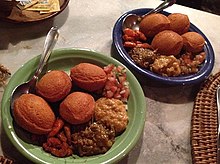Akara
Beans, deep-fried in palm oil or peanut oil. | |

Àkàrà (Yoruba) (
Akara is made from peeled beans (black-eyed peas), washed and ground with pepper, and other preferred seasonings, then beaten to aerate them, and deep-fried in small balls.[3][4]
Brazilian acarajé is made from raw and milled
Etymology
Àkàrà is a Yoruba word meaning "pastry", or the dish itself. The Brazilian term "acarajé" derives from either the Yoruba word combinations "àkàrà" (bread) and "onje" (food), or "àkará" (a round pastry) and "je" (to eat).[6][7] Márcio de Jagun states that the word is derived from the Yoruba àkàrà n'jẹ, or "come and eat àkàrà"; the phrase was used to call out to customers by women selling acarajé on the street.[8][9]
History

Akara plays a significant role in the
Akara (as it is known in southwest Nigeria) a recipe taken to Brazil by the enslaved peoples from the West African coast. It is called "akara" by the Yoruba people of south-western Nigeria and by the citizens of Sierra Leone, "kosai" by the Hausa people of Nigeria or "koose" in Ghana and is a popular breakfast dish, eaten with millet or corn pudding. In Nigeria, akara is commonly eaten with bread, ogi (or eko), a type of cornmeal made with fine corn flour.
In Sierra Leone, akara is composed of rice flour, mashed banana, baking powder, and sugar. After mixed together, it is dropped in oil by hand, and fried, similar to Puff-puff. It is then formed into a ball. Akara is usually prepared for events like Pulnado (event held due to the birth of a child), a wedding, funeral, or party.
In Brazil

Acarajé sold on the street in Brazil are variously made with fried beef, mutton, dried shrimp, pigweed, fufu osun sauce, and coconut.[6] Today in Bahia, Brazil, most street vendors who serve acarajé are women, easily recognizable by their all-white cotton dresses and headscarves and caps. They first appeared in Bahia selling acarajé in the 19th century. Earnings from the sale of acarajé were used both to buy the freedom of enslaved family members until the abolition of slavery in Brazil in 1888; its sale additionally served as a source of family income.[9] The city now has more than 500 acarajé vendors. The image of these women, often simply called baianas, frequently appears in artwork from the region of Bahia.[1][2][10] Acarajé, however, is available outside of the state of Bahia as well, including the streets of its neighborboring state of Sergipe, and the markets of Rio de Janeiro.[11]
In Candomblé
Acarajé is an essential ritual food used in
Acarajé de azeite-doce
Acarajé de azeite-doce is a variety of acarajé fried in an oil other than palm oil; olive oil or other vegetable oils are generally used. Acarajé de azeite-doce is used in Candomblé offerings to orixás with a ritual prohibition of the use of palm oil. This variety is found in the states of Bahia and Rio de Janeiro.[11]
Acarajé de Xangô (Sango)
Acarajé de Xangô (Àkàrà tí Ṣangó) is a variety of acarajé offered to the orixá Xangô, known as the òriṣà Ṣangó in the Yoruba culture. It is made of the same ingredients as the common form but greatly elongated. This variety is found on the ritual platter of amalá offered to Xangô. This variety is found in the states of Bahia and states of Bahia and Rio de Janeiro.[11]
Protected status
Acarajé was listed as a national intangible historic heritage (patrimônio nacional imaterial), by the National Institute of Historic and Artistic Heritage in 2004; the role of baianas in the preparation and sale of acarajé was recognized in the same act.[9] In October 2023, Rio de Janeiro declared the fritter to be part of that city's cultural heritage.[12]
Nutrition
Akara is a good source of proteins, vitamins and minerals such as calcium, iron and zinc,
In popular culture
Akara (acarajé) was featured on the
See also
- Cuisine of Nigeria– Culinary traditions of Nigeria
- Acaçá – Maize dish in Brazil
- Vada (food) – Category of savoury fried snacks from India
- Falafel – Middle Eastern fried bean dish
- List of African dishes – Dishes found in African cuisine
- List of Brazilian dishes
- List of legume dishes
References
- ^ ISBN 9781442266438.
- ^ a b c d "Significado do acarajé no candomblé" (in Portuguese). Brasília, Brazil: Instituto do Patrimônio Histórico e Artístico Nacional (Iphan). 2014. Archived from the original on 2019-01-01. Retrieved 2016-10-01.
- ^ "How to make Akara/kosai - African Bean Fritters recipe". Chef Lola's Kitchen. 2021-04-06. Retrieved 2022-06-01.
- ^ "Pap & akara bean balls with sweet plantain (Breakfast) Recipe by Da-Princess Kitchen Culinary Concept(Chef DPK)". Cookpad. 20 October 2021. Retrieved 2022-06-01.
- ^ Blazes, Marian. "Brazilian Black-Eyed Pea and Shrimp Fritters - Acarajé". About.com. Archived from the original on 29 April 2013. Retrieved 17 May 2012.
- ^ ISBN 9788567855264.
- ^ Ali, Mohammed. "Akara | Deep-fried bean-flour fritter known all over Northern-Niger..." Yerwa Express News. Retrieved 2022-06-01.[permanent dead link]
- ISBN 9788537402573.
- ^ ISBN 9788537403181.
- ISBN 9781317689911.
- ^ ISBN 9788534701877.
- ^ "Acarajé se torna Patrimônio Histórico e Cultural do Rio e causa polêmica entre baianos".
- ^ .
- ISSN 0889-1575.
- ^ Anderson, John. "'Street Food: Latin America' Review: A Platter of Vicarious Delights". WSJ. Dow Jones & Company, Inc. Retrieved 9 September 2020.

